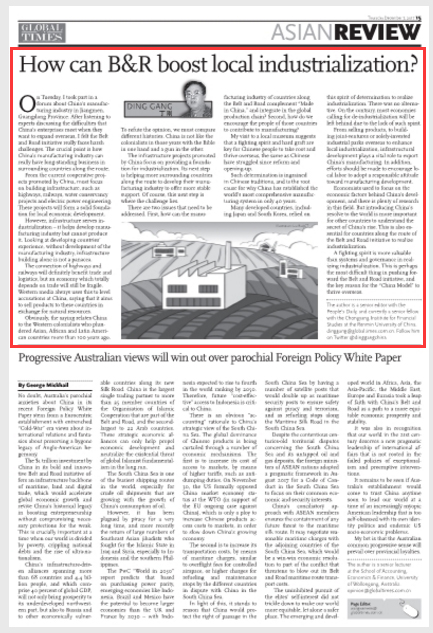Belt and Road
Your Present Location: PROGRAMS> Belt and RoadDing Gang: How can B&R boost local industrialization?
By Ding Gang Source:Global Times Published: 2017-12-6
On Tuesday, I took part in a forum about China`s manufacturing industry in Jiangmen, Guangdong Province. After listening to experts discussing the difficulties that China`s enterprises meet when they want to expand overseas, I felt the Belt and Road initiative really faces harsh challenges. The crucial point is how China`s manufacturing industry can really have long-standing business in surrounding countries along the route.
From the current cooperative projects promoted by China, most focus on building infrastructure, such as highways, railways, water conservancy projects and electric power engineering. These projects will form a solid foundation for local economic development.

However, infrastructure serves industrialization - it helps develop manufacturing industry but cannot produce it. Looking at developing countries` experience, without development of the manufacturing industry, infrastructure building alone is not a panacea.
The connection of highways and railways will definitely benefit trade and logistics, but an economy which totally depends on trade will still be fragile. Western media always uses this to level accusations at China, saying that it aims to sell products to these countries in exchange for natural resources.
Obviously, the saying relates China to the Western colonialists who plundered Asian, African and Latin American countries more than 100 years ago. To refute the opinion, we must compare different histories. China is not like the colonialists in those years with the Bible in one hand and a gun in the other.
The infrastructure projects promoted by China focus on providing a foundation for industrialization. Its next step is helping more surrounding countries along the route to develop their manufacturing industry to offer more stable support. Of course, this next step is where the challenge lies.
There are two issues that need to be addressed. First, how can the manufacturing industry of countries along the Belt and Road complement "Made in China," and integrate in the global production chain? Second, how do we encourage the people of those countries to contribute to manufacturing?
My visit to a local museum suggests that a fighting spirit and hard graft are key for Chinese people to take root and thrive overseas, the same as Chinese have struggled since reform and opening-up.
Such determination is ingrained in Chinese traditions, and is the root cause for why China has established the world`s most comprehensive manufacturing system in only 40 years.
Many developed countries, including Japan and South Korea, relied on this spirit of determination to realize industrialization. There was no alternative. On the contrary, most economies calling for de-industrialization will be left behind due to the lack of such spirit.
From selling products, to building joint-ventures or solely-invested industrial parks overseas to enhance local industrialization, infrastructural development plays a vital role to export China`s manufacturing. In addition, efforts should be made to encourage local labor to adopt a responsible attitude toward manufacturing development.
Economists used to focus on the economic factors behind China`s development, and there is plenty of research in this field. But introducing China`s resolve to the world is more important for other countries to understand the secret of China`s rise. This is also essential for countries along the route of the Belt and Road initiative to realize industrialization.
A fighting spirit is more valuable than systems and governance in realizing industrialization. This is perhaps the most difficult thing in pushing forward the Belt and Road initiative, and the key reason for the "China Model" to thrive overseas.
The author is a senior fellow with the Chongyang Institute for Financial Studies at the Renmin University of China.
Key Words: Belt; industrialization; RDCY; Ding Gang























































































 京公网安备 11010802037854号
京公网安备 11010802037854号





